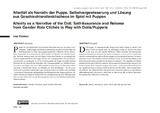Citation link:
http://dx.doi.org/10.25819/dedo/128Files in This Item:
| File | Description | Size | Format | |
|---|---|---|---|---|
| Fooken_Alteritaet_als_Narrativ_34-42_Dedo5.pdf | 2.16 MB | Adobe PDF |  View/Open |
| Dokument Type: | Article | metadata.dc.title: | Alterität als Narrativ der Puppe. Selbstvergewisserung und Lösung aus Geschlechtsrollenklischees im Spiel mit Puppen | Other Titles: | Alterity as a Narrative of the Doll. Self-Assurance and Release from Gender Role Clichés in Play with Dolls/Puppets | Authors: | Fooken, Prof. Dr. Insa | Free keywords: | Alterität, Affordanz, performatives Potenzial, Geschlechterrollen, alterity, affordance, performative potential, gender roles | Issue Date: | 2022 | Publish Date: | 2022 | Publisher: | universi - Universitätsverlag Siegen | Journal: | denkste: puppe / just a bit of: doll (de:do) | Source: | denkste: puppe - multidisziplinäre zeitschrift für mensch-puppen-diskurse; Bd. 5 Nr. 1 (2022): Puppen und Puppenfiguren in Narrativen – Themen und Motive in Literatur, Kunst, Theater, Film, Medien, Alltags- und Populärkulturen ; 34-42 | Abstract: | Puppen als anthropomorphe Wesen fordern Menschen dazu auf, mit ihnen zu interagieren. Treffen Puppe und Mensch aufeinander, entsteht durch die Puppe ein Handlungsanreiz im Sinne einer puppenspezifischen Affordanz, die im menschlichen Gegenüber das innerpsychische Wechselspiel von Identität und Alterität anregt. Die These des Beitrags lautet, dass der Puppe situativ eine Alterität als psychologisches Narrativ eingeschrieben ist: Die Puppe wird als alter wahrgenommen, was mit dem Bewusstsein für ego einhergeht. Es ist ein Alteriätsangebot der Puppe mit performativem Potenzial für das menschliche Gegenüber. Das Zusammentreffen von Alteritäts-Narrativ (seitens der Puppe) und neuer Selbstvergewisserung (seitens des Menschen) findet sich auch in literarischen Texten. Am Beispiel von zwei Erzählungen – Ein Emigrant (1914/1930) von Selma Lagerlöf und Popp und Mingel (1960) von Marie Luise Kaschnitz – wird diesen Überlegungen nachgegangen: Zwei heranwachsende Jungen greifen das Alteritäts-Narrativ der Puppe als Potenzial für die Ausdifferenzierung ihres Selbstkonzepts auf, was dazu führt, dass sie sich für eine gewisse Zeit aus Geschlechtsrollenklischees entlassen können. Dolls/puppets as anthropomorphic beings invite human beings to interact with them. If doll and human meet, the doll/puppet creates an incentive for action in the sense of a doll-specific affordance, which stimulates the inner-psychic interplay of identity and alterity in the human counterpart. In the paper it is argued that alterity is situationally inscribed in the doll/puppet as a psychological narrative: the doll is perceived as alter that correlates with an awareness of ego. It is an alterity offered by the doll with a performative potential for the human counterpart. The coincidence of alterity narrative (on the part of the doll) and new self-assurance (on the part of the human) is also found in literary texts. Using the example of two stories – An Emigrant (1914/1930) by Selma Lagerlöf and Popp and Mingel (1960) by Marie Luise Kaschnitz – these considerations are explored: Two adolescent boys take up the doll's narrative of alterity as a potential for differentiating their self-concept, which leads to their being able to release themselves from gender role clichés for a certain time. |
DOI: | http://dx.doi.org/10.25819/dedo/128 | URN: | urn:nbn:de:hbz:467-24099 | URI: | https://dedo.ub.uni-siegen.de/index.php/de_do/article/view/128 https://dspace.ub.uni-siegen.de/handle/ubsi/2409 |
License: | http://creativecommons.org/licenses/by-sa/4.0/ |
| Appears in Collections: | universi - Zeitschriftenartikel |
This item is protected by original copyright |
Page view(s)
372
checked on Nov 25, 2024
Download(s)
140
checked on Nov 25, 2024
Google ScholarTM
Check
Altmetric
This item is licensed under a Creative Commons License


